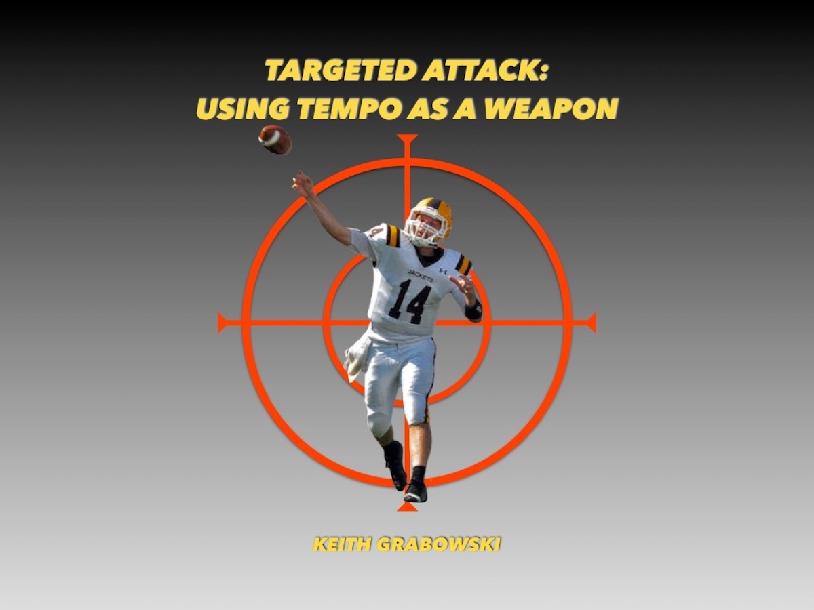Many teams view tempo as something that is used exclusively for no-huddle teams. In many coaches’ eyes, tempo is only for the team trying to run 80 plays a game. On the other end of the spectrum, a ball-control team looking to win time of possession doesn't need to use tempo. For teams I consult with, whether huddle or no huddle, I have tempo tools that I suggest for a team operating under either procedure. These tools are effective in any type of team’s attack.
Again
Having the ability to communicate to your team to get up to the ball and run the exact same play again is an effective way to continue to exploit a defense when you feel you have them exactly where you want them. The procedure for us is simple: We have a code word that is signaled in to the entire offense and relayed to everyone. It tells them to align in the same formation and run the exact same play as soon as the ball is spotted. If the previous play has motion, the player who went in motion simply aligns in the spot that he motioned to. Use the hyperlinks below to go to the information on each
Flip it
Similar to our Again procedure is “Flip It.” The players get the code word from the sideline, and it is relayed to everyone quickly. The only difference with Flip It is that it is used for boundary and field sensitive plays, such as 3x1 zone read bubble or 3x1 stick-draw. We align in the opposite formation and run the play to the other side.
Just having these two tools in your offense is a great start. It allows you to put the defense on their heels. Most times, a defense will get into a base look or run the same defense as the previous snap.
No Play
Once we have run a series of these plays, the most basic way we get out of the play is to align in the same formation, false cadence and freeze to try to induce the defense to jump. At the college level, this entails snapping the ball when the defense is offsides. At high school, once the defense crosses into the neutral zone, it is automatically penalized five yards. Regardless, the likelihood of getting the defense to move is great because we were operating at a fast pace and snapping the ball quickly. They are put into a situation that they are just trying to align as fast as they can. Not jumping offsides isn't the first thing on the defensive lineman’s mind.
Sequenced plays
Another tool I suggest is a series of three plays without a huddle. We typically call our base run, a counter off of it, then a play action. All of these are from the same personnel and formation. If we use motion, it will be on the first play only with all subsequent plays having the motion player align where he was after the motion. Procedurally, the offense will look to the sideline after the first play to confirm we are still in the sequence. If something happens where we don’t want to run the play, we just signal in a different tempo, and we move on. We like to use this at the beginning of a series or after we pick up a first down.
The Up-Tempo Huddle
The other tool that I am intensely interested in is the up-tempo huddle. For teams that changed personnel, I believe this is the best way to operate. More and more, the official will stand over the ball and hold the snap until the defense makes its changes. Aligning and presenting to the defense is no longer an advantage.
After the quarterback calls the play once with the snap count, the receivers leave the huddle to get a head start to get to their position, then the quarterback repeats the cadence (some teams would repeat the whole call) and says “ready” and the remaining players say, “Break” while clapping their hands and getting to the line of scrimmage.
As explained in the previous chapter, there’s a slight twist on Auburn’s huddle, which allows them to get in motion and snap the ball within four seconds of breaking the huddle.
Consider incorporating these simple yet effective tools into your offense. Think of tempo as another facet of your offensive attack. Be sure to practice these procedures during the week. Don’t expect to just break them out on game day and have them be effective. It takes only a little practice for your players to understand these procedures and make them work in the game.
1
2
3
4
5
6
7
8
9
10
11
12
13
14
15
16
17
18
19
20
21
22
23
24
25
26
27
28
29
30
31
32
33
34
35
36
37
38
39
40
41
42
43
44
45
46
47
48
49
50
51
52
53
54
55
56
57
58
59
Lesson 60:
Tempos for Any Offense
61
62
63

Part of the Black Friday/Cyber Monday OC School Bundle
